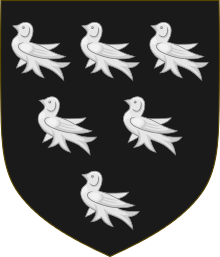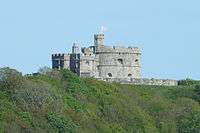John Arundell (born 1576)

John VII Arundell (1576–1654),[1] Esquire, of Trerice in Cornwall, later given the epithet "Jack for the King", was a member of an ancient Cornish gentry family, who as a Royalist during the Civil War served King Charles I as Governor of Pendennis Castle, Falmouth, which in 1646 he retained in a heroic manner during a five month long siege by Fairfax, during which his forces were reduced by hunger to eating their horses, and finally received an honourable surrender. He served twice as MP for the prestigious county seat of Cornwall (1601 and 1621), and for his family's pocket boroughs[2] of Tregony (1628) and Mitchell (1597) and also for St Mawes (1624).[3] His family "of Trerice" should not be confused with the contemporary ancient and even more prominent Cornish family of Arundell "of Lanherne", six miles north of Trerice, "The Great Arundells",[4] with which no certain shared origin has been found,[5] but which shared the same armorials, the Arundell swallows.
Origins

He was born in 1576 the eldest son and heir, by his second wife, of John VI Arundell (d.1580) of Trerice, a Member of Parliament for Mitchell, Cornwall, in 1555 and 1558, and Sheriff of Cornwall in 1573-1574, who built the present mansion house at Trerice in about 1572.[6] His mother was Gertrude Denys, a daughter of Sir Robert Denys (d.1592) of Holcombe Burnell in Devon, by his first wife Mary Mountjoy (a first cousin to Lady Jane Grey[7]), a daughter of William Blount, 4th Baron Mountjoy (1478–1534),[8] by his fourth wife Dorothy Grey, daughter of Thomas Grey, 1st Marquess of Dorset. Gertrude survived her husband and remarried to Edward, Lord Morley.[9] John VII's younger brother was Thomas Arundell of Duloe, Cornwall, MP for West Looe, a soldier who served in the Netherlands.[10] His grandfather was Sir John IV Arundell (1495–1561), of Trerice, later known as Jack of Tilbury, an Esquire of the Body to King Henry VIII whom he served as Vice-Admiral of the West. He was knighted at the Battle of the Spurs in 1513 and was twice as Sheriff of Cornwall, in 1532 and in 1541.[10]
Career


In 1597 he was elected Member of Parliament for Mitchell, Cornwall, a pocket borough. He subsequently served as MP for the prestigious county seat of Cornwall in 1601 and 1621 and was Sheriff of Cornwall in 1607. He was elected MP for St Mawes in 1624 and for Tregony in 1628, and sat until 1629 when King Charles I decided to rule without parliament for eleven years.[11] In April 1640 he was re-elected as MP for Tregony in the Short Parliament. He was not elected to the Long Parliament, unlike his two sons, Richard Arundell, elected for Lostwithiel and John Arundell for Bodmin.[11] Following the outbreak of the Civil War he was a Royalist, remaining loyal to the King, and was present in 1643 at the Royalist victory at the Battle of Braddock Down in Cornwall. In about 1643 he was appointed governor of the royal Pendennis Castle in Cornwall, built by King Henry VIII to guard the entry to Falmouth Harbour. After the Royalist defeat at the Battle of Naseby in June 1645, the Parliamentary army swept through the West Country, and Arundell defiantly refused the demand of General Fairfax to submit, and replied to him:[2]
- "I wonder you demand the castle without authority from His Majesty, which if I should render, I brand myself and my posterity with the indelible character of treason. And having taken less than two minutes resolution, I resolve that I will here bury myself before I deliver up this castle to such as fight against His Majesty, and that nothing you can threaten is formidable to me in respect of the loss of loyalty and conscience".
He maintained a five month long siege in heroic circumstances, during which his garrison was reduced by hunger to eating their horses. Finally he surrendered in August 1646, making Pendennis Castle the last but one to have held out for the King. In 1651, following the establishment of the Commonwealth, he was fined £10,000 by the new government, a large sum later reduced to £2,000,[2] and although his estates were sequestered and let, he was able to retrieve them on payment of a further sum.
Marriage & progeny
He married Mary Cary, a daughter of George I Cary (1543-1601) of Clovelly, Devon, Sheriff of Devon in 1587,[12] who constructed the harbour wall at Clovelly, by whom he had progeny including:
- John VIII Arundell (1613-1701), of Trerice, eldest son and heir, MP,[13] who died without progeny
- Richard Arundell, 1st Baron Arundell of Trerice (1616-1687), 2nd son. He was raised to the peerage following the Restoration of the Monarchy by King Charles II, partly in recompense for his father's Royalist sentiment and heroic defence of Pendennis Castle. Before his elevation to the peerage he served twice as MP for Lostwithiel, April 1640 and November 1640 to January 1644, and twice for Bere Alston, 1660 and 1662-1665.[14]
- Nicholas Arundell (1623-1666), of Gwarnick, near Truro, 3rd son, MP for Truro 1661-6.[15] The old Beville seat of Gwarnick had been inherited on the first marriage of his great-grandfather "Jack of Tilbury" was situated 3 miles north-west of Truro.
Death
Arundell died in December 1654,[2] six years before the Restoration of the Monarchy in 1660, when the family's fortunes were restored and when his second son, Richard Arundell, who had been active in the Sealed Knot conspiracy, was raised to the peerage by King Charles II as Baron Arundell of Trerice, partly in recognition of his father's service to the Crown.
Literary portrayals
He is a character in the historical novel The Grove of Eagles by Winston Graham.
See also
Sources
- Duffin, Anne & Hunneyball, Paul, biography of Arundell, John (1576-1654), of Trerice, Newlyn, Cornw., published in History of Parliament, House of Commons 1604-1629, ed. Andrew Thrush and John P. Ferris, 2010
- Vivian, Lt.Col. J.L., (Ed.), The Visitations of Cornwall: Comprising the Heralds' Visitations of 1530, 1573 & 1620; with additions by J.L. Vivian, Exeter, 1887, pp. 11 et seq. Pedigree of Arundell of Trerice
References
- ↑ Date of death 1654 per Duffin & Hunneyball
- 1 2 3 4 Duffin & Hunneyball
- ↑ Duffin, Anne & Hunneyball, Paul, biography of Arundell, John (1576-1654), of Trerice, Newlyn, Cornw., published in History of Parliament, House of Commons 1604-1629, ed. Andrew Thrush and John P. Ferris, 2010
- ↑ Leland, quoted in Magna Britannia, Vol.3, 1814, Cornwall: General history: Extinct peers and baronial families
- ↑ Lysons, Magna Britannia, Vol.3, 1814, Cornwall: General history: Extinct peers and baronial families)
- ↑ Visitation of the County of Cornwall in the Year 1620
- ↑ Vivian, Lt.Col. J.L., (Ed.) The Visitations of the County of Devon: Comprising the Heralds' Visitations of 1531, 1564 & 1620, Exeter, 1895, p.102
- ↑ Vivian, 1895, p.280, pedigree of Dennis of Holcombe Burnell, erroueously "Walter, Lord Mountjoy"
- ↑ Vivian, 1895, p.280
- 1 2 Vivian, 1887, p.12
- 1 2 Willis, Browne (1750). Notitia Parliamentaria, Part II: A Series or Lists of the Representatives in the several Parliaments held from the Reformation 1541, to the Restoration 1660 ... London. pp. 229–239.
- ↑ Vivian, 1895, pedigree of Cary
- ↑ See History of Parliament biography of his brother Nicholas
- ↑ History of Parliament biography
- ↑ History of Parliament biography
- Dictionary of National Biography
- D Brunton & D H Pennington, Members of the Long Parliament (London: George Allen & Unwin, 1954)
| Parliament of England | ||
|---|---|---|
| Preceded by Sir Walter Raleigh Richard Reynell |
Member of Parliament for Mitchell 1597 With: John Carew |
Succeeded by George Chudleigh William Cholmley |
| Preceded by William Killigrew Jonathan Trelawny |
Member of Parliament for Cornwall 1601 With: Sir Walter Raleigh |
Succeeded by Sir Anthony Rous Sir Jonathan Trelawny |
| Preceded by Richard Carew John St Aubyn |
Member of Parliament for Cornwall 1621-1622 With: Bevil Grenville |
Succeeded by Bevil Grenville William Coryton |
| Preceded by Edward Wrightington John Hockmere |
Member of Parliament for St Mawes 1624 With: William Hockmere |
Succeeded by Sir James Fullerton Nathaniel Tomkins |
| Preceded by Thomas Carey Sir Robert Killigrew |
Member of Parliament for Tregony 1628-1629 With: Francis Rous |
Succeeded by Parliament suspended until 1640 |
| Preceded by Parliament suspended since 1629 |
Member of Parliament for Tregony 1640 With: John St Aubyn |
Succeeded by Sir Richard Vyvyan John Polwhele |